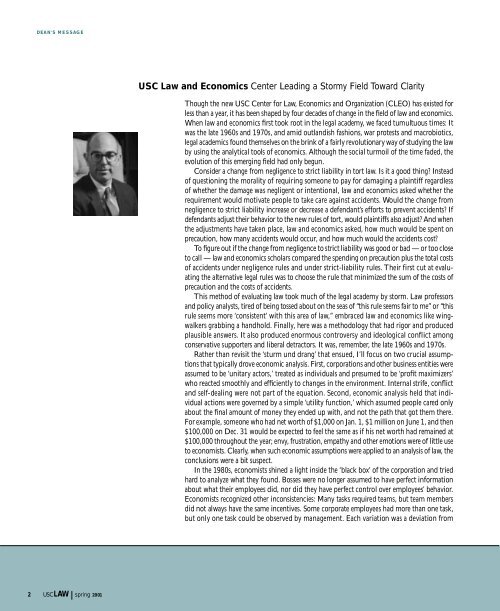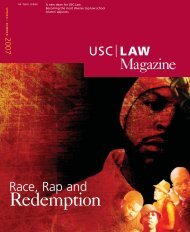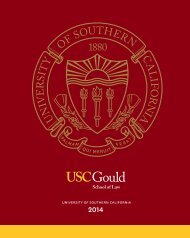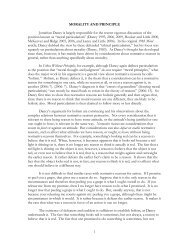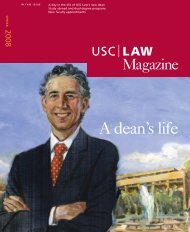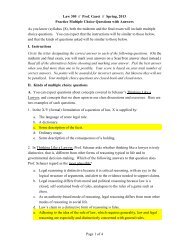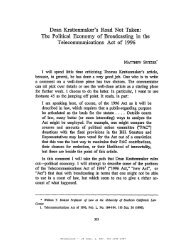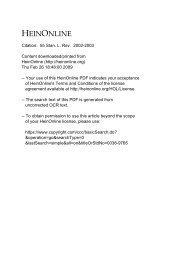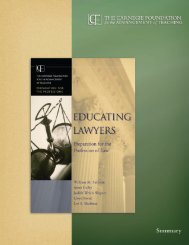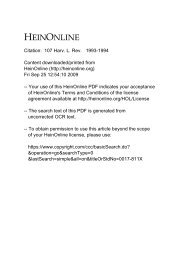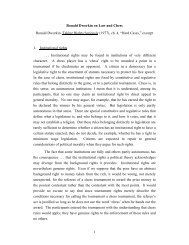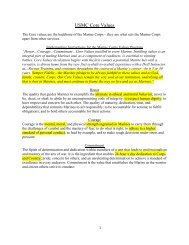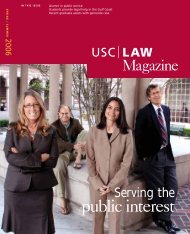usclaw - USC Gould School of Law - University of Southern California
usclaw - USC Gould School of Law - University of Southern California
usclaw - USC Gould School of Law - University of Southern California
Create successful ePaper yourself
Turn your PDF publications into a flip-book with our unique Google optimized e-Paper software.
DEAN’S M E SS AG E<br />
<strong>USC</strong> <strong>Law</strong> and Economics Center Leading a Stormy Field Toward Clarity<br />
Though the new <strong>USC</strong> Center for <strong>Law</strong>, Economics and Organization (CLEO) has existed for<br />
less than a ye a r, it has been shaped by four decades <strong>of</strong> change in the field <strong>of</strong> law and economics.<br />
When law and economics first took root in the legal academy, we faced tumultuous times: It<br />
was the late 1960s and 1970s, and amid outlandish fashions, war protests and macro b i o t i c s ,<br />
legal academics found themselves on the brink <strong>of</strong> a fairly re vo l u t i o n a ry way <strong>of</strong> studying the law<br />
by using the analytical tools <strong>of</strong> economics. Although the social turmoil <strong>of</strong> the time faded, the<br />
e volution <strong>of</strong> this emerging field had only begun.<br />
Consider a change from negligence to strict liability in tort law. Is it a good thing? In s t e a d<br />
<strong>of</strong> questioning the morality <strong>of</strong> requiring someone to pay for damaging a plaintiff re g a rd l e s s<br />
<strong>of</strong> whether the damage was negligent or intentional, law and economics asked whether the<br />
re q u i rement would motivate people to take care against accidents. Would the change fro m<br />
negligence to strict liability increase or decrease a defendant’s efforts to pre vent accidents? If<br />
defendants adjust their behavior to the new rules <strong>of</strong> tort, would plaintiffs also adjust? And when<br />
the adjustments have taken place, law and economics asked, how much would be spent on<br />
p recaution, how many accidents would occur, and how much would the accidents cost?<br />
To fig u re out if the change from negligence to strict liability was good or bad — or too close<br />
to call — law and economics scholars compared the spending on precaution plus the total costs<br />
<strong>of</strong> accidents under negligence rules and under strict-liability rules. Their first cut at eva l u-<br />
ating the alternative legal rules was to choose the rule that minimized the sum <strong>of</strong> the costs <strong>of</strong><br />
p recaution and the costs <strong>of</strong> accidents.<br />
This method <strong>of</strong> evaluating law took much <strong>of</strong> the legal academy by storm. <strong>Law</strong> pro f e s s o r s<br />
and policy analysts, tired <strong>of</strong> being tossed about on the seas <strong>of</strong> “this rule seems fair to me” or “t h i s<br />
rule seems more ‘c o n s i s t e n t’ with this area <strong>of</strong> law,” embraced law and economics like wingwalkers<br />
grabbing a handhold. Fi n a l l y, here was a methodology that had rigor and pro d u c e d<br />
plausible answers. It also produced enormous controversy and ideological conflict among<br />
c o n s e rva t i ve supporters and liberal detractors. It was, re m e m b e r, the late 1960s and 1970s.<br />
Rather than revisit the ‘sturm und drang’ that ensued, I’ll focus on two crucial assumptions<br />
that typically drove economic analysis. First, corporations and other business entities we re<br />
assumed to be ‘u n i t a ry actors,’ treated as individuals and presumed to be ‘p ro fit maximize r s’<br />
who reacted smoothly and efficiently to changes in the environment. Internal strife, confli c t<br />
and self-dealing we re not part <strong>of</strong> the equation. Second, economic analysis held that individual<br />
actions we re governed by a simple ‘utility function,’ which assumed people cared only<br />
about the final amount <strong>of</strong> money they ended up with, and not the path that got them there .<br />
For example, someone who had net worth <strong>of</strong> $1,000 on Jan. 1, $1 million on June 1, and then<br />
$100,000 on Dec. 31 would be expected to feel the same as if his net worth had remained at<br />
$100,000 throughout the year; envy, frustration, empathy and other emotions we re <strong>of</strong> little use<br />
to economists. Clearly, when such economic assumptions we re applied to an analysis <strong>of</strong> law, the<br />
conclusions we re a bit suspect.<br />
In the 1980s, economists shined a light inside the ‘black box’ <strong>of</strong> the corporation and tried<br />
h a rd to analyze what they found. Bosses we re no longer assumed to have perfect information<br />
about what their employees did, nor did they have perfect control over employe e s’ behavior.<br />
Economists re c o g n i zed other inconsistencies: Many tasks re q u i red teams, but team members<br />
did not always have the same incentives. Some corporate employees had more than one task,<br />
but only one task could be observed by management. Each variation was a deviation fro m<br />
2 <strong>USC</strong>LAW s p r i n g 2001


